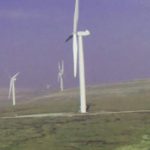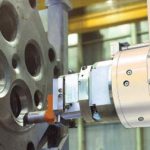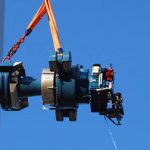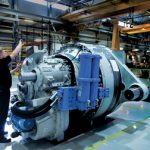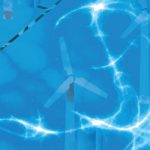Research and development activity at the world’s top wind-power companies has given rise to hundreds of new patents pertaining to all elements of wind turbine design, manufacture, and operation. Since 2001, the number of U.S. patents issued for innovations in wind power technology has continually increased, as seen in Figure 1. The 2011 projections are based on patents issued through September 30, 2011.
The last decade has seen the concentration of wind-power patents in a handful of top companies. Many companies recognize that a strong intellectual property position is important to protect their investments in research and development and to secure their market position. Patent leader General Electric entered the wind-power marketplace in 2002 when it acquired the assets of the Enron Wind Corp. and formed GE Wind Energy. GE has grown its wind patent portfolio rapidly since then, and it has been issued more wind-technology patents each year than any other company. Enercon, another market leader, benefits from a significant U.S. patent portfolio held by its founder and managing director, Aloys Wobben. Vestas Wind Systems began protecting its intellectual property in the U.S. in 2001, when it filed its first patent application. Vestas’ first U.S. patent was issued in 2003.
However, as reflected in Figure 2, a significant portion of wind-technology patents are held by smaller players. They are made up of more than 100 individuals and companies including Acciona, Aerodyne Engineering, Clipper Windpower, DeWind, Gamesa, Northern Power Systems, and Valmont Industries.
Some companies have specific research focal points. For example, the ABB Group, headquartered in Switzerland, holds several patents for wind farm design, wind farm management, and operations methods for flexible and efficient energy delivery. Clipper Windpower, a Canadian turbine manufacturer, has patented several generator designs, as well as extendable/retractable rotor blades for wind and water turbines. Hitachi holds several patents on wind turbine generator designs. Dutch turbine maker NEG Micon, which was acquired by Vestas, focused research efforts on managing and dampening unwanted turbine blade oscillation, including using liquids within blade components to counteract blade stress. Valmont Industries, headquartered in Nebraska, has focused on towers and structures and has several patents relating to methods for erecting a wind turbine rotor on top of a tower.
Patented innovations in the wind-power industry have focused on several key areas, including improved equipment design, especially for wind towers in remote locations; improved construction and assembly methods; and improved control and management techniques. With respect to equipment, inventors have continued to refine the basic components of the wind turbine and blades to improve efficiency, longevity, and safety. To compensate for the material degradation wind turbines face from their reliance on the elements, companies also have patented mechanical improvements and methods for reducing wear and damage from lightning, salt water, and ambient particulates that wear the turbine rotors. Turbine makers also have patented a number of strategies for managing the heat created by wind turbines, using air or water cycles to provide a renewable coolant. Several leading companies also have patented methods of noise dampening to make wind farms better neighbors and to overcome opposition to wind turbine installation.
A second key area, construction and assembly methods, has seen innovations directed to improving the ability to install wind farms in remote locations. Companies have patented a variety of methods for constructing turbine towers or pylons that reduce the use of cranes and heavy weights. They also have patented systems for remote monitoring of wind farms, including farms that take advantage of less accessible locations with favorable wind conditions.
Proper management and control has been a third focus. Because the wind does not always blow steadily, wind turbines must negotiate between variable blade rotation and the need of the commercial power grid for steady, fixed rates of electricity production. Inventors have addressed these problems, and the associated risks from power surges and abrupt cutoffs, with patented energy storage systems and techniques to balance turbine output within a wind farm. Recently issued patents describe improvements to reduce energy wasted in transfer to the electrical grid, and to maintain the economies of scale promoted by large rotor diameters. Monitoring systems also have been widely patented. A number of strategies have been developed to address and alert operators to the risks of wind sheer, imbalance of wind flow across a rotor, and material fatigue. There are several patented systems for alerting aircraft to the presence of wind turbines.
Patent Litigation
As the installed base of wind energy increases and wind power becomes increasingly valuable, and as patent portfolios continue to grow, patent litigation is likely to become more frequent. Enforcing their patents gives companies the opportunity to generate revenues based on their inventions, which can be re-invested to develop new technology, and to protect their exclusivity in the marketplace. A review of the litigation landscape indicates that a handful of wind-technology patents have been litigated thus far, and more could be on the way.
GE filed a complaint with the U.S. International Trade Commission (ITC) in 2008 seeking to bar Mitsubishi Heavy Industries (MHI) from importing wind turbines and components alleged to infringe three GE patents. The patents are generally directed to maintaining continuous turbine operation despite changing wind speeds and low voltage events, as well as to decoupling turbines from the grid to avoid damage from power fluctuations. In January 2010 the ITC ruled in favor of MHI. In re Certain Variable Speed Wind Turbines and Components Thereof, Investigation No. 337-TA-641. GE appealed the ITC decision to the U.S. Court of Appeals for the Federal Circuit. In a split decision, the Federal Circuit recently (1) affirmed that MHI’s wind turbines did not infringe one GE patent, (2) reversed the ITC’s ruling on a second patent and remanded the case to the ITC for further proceedings on that patent, and (3) found that the appeal was moot with respect to the third patent because it expired in February 2011. General Electric Co. v. ITC, No. 2010-1223 (Fed. Cir. Feb. 29, 2012).
The dispute between GE and MHI has resulted in further litigation in three federal district courts. First, before the ITC issued its decision, GE sued MHI in Texas for infringing the patents involved in the ITC investigation. General Electric Co. v. Mitsubishi Heavy Indus., Ltd., No. 2:09-cv-00229 (S.D. Tex., filed September 3, 2009). Shortly after filing, that case was stayed (and remains stayed) pending the outcome of the ITC investigation. Next, GE sued MHI in a different Texas court for infringing a new set of patents related to wind turbines. After a seven-day trial in that case, on March 8, 2012, the jury awarded over $170 million in damages to GE for MHI’s infringement of U.S. Patent No. 7,629,705, titled “Method and Apparatus for Operating Electrical Machines.” A separate trial on MHI’s inequitable conduct defense will be held later. General Electric Co. v. Mitsubishi Heavy Indus., Ltd., No. 3:2010-cv-00276 (N.D. Tex., filed Feb. 11, 2010). MHI countered with an antitrust lawsuit asserting that GE fraudulently obtained patents and pursued “sham “ litigation. Mitsubishi Heavy Indus., Ltd. v. General Electric Co., No. 5:10-cv-05087 (W.D. Ark., filed May 20, 2010). The antitrust case is on hold pending the outcome of the patent cases. GE also sued an inventor—a former GE employee—over rights to certain patented technology, and MHI intervened in that lawsuit. General Electric Co. v. Wilkins, No. 1:10-cv-00674 (E.D. Cal., filed Apr. 15, 2010).
In an earlier lawsuit, Gamesa Eolica, S.A. v. General Electric Co., 359 F. Supp. 2d 790 (W.D. Wisc. 2005), Gamesa sued GE in 2004 for infringement of a patent related to a variable speed wind turbine with a special control strategy based on electrical adjustment of generator torque. The parties disputed the scope and interpretation of the patent claims, and the court sided with defendant GE. Ultimately, GE was cleared of any direct infringement.
GE is not the only litigant in the wind energy space. One of the same patents at issue in the GE-MHI dispute was litigated 10 years earlier, in Enercon GmbH v. ITC, 151 F.3d 1376 (Fed. Cir. 1998). The Federal Circuit upheld an ITC ruling that Enercon had sold infringing variable speed wind turbines for importation into the U.S. The key issue on appeal was claim interpretation. Enercon, the accused infringer, lost the appeal and was barred from shipping some of its turbine designs into the U.S.
In Baseload Energy, Inc. v. Roberts, No. 1:08-cv-01838 (D.D.C., filed Oct. 27, 2008), Baseload sought a declaratory judgment that Robert’s patent, directed to kite-based power generation, was invalid. The case has progressed slowly since the Federal Circuit ruled in September 2010 that Baseload’s claims were not barred by an earlier settlement. Finally, Vestas sued Beaird over three patents relating to wind-turbine support towers, seeking a judgment that it did not infringe. Vestas-American Wind Technology, Inc. v. Beaird Company, Ltd. et al., No. 3:07-cv-01651 (D. Or., filed Nov. 2, 2007). The case settled in March 2009.
Strategic Enforcement
Whether your company is seeking to enforce its patent portfolio or is an accused infringer, it is important to remember that not all patents are created equal. Some are “pioneer patents” entitled to broad scope, while others are “improvement patents” that are more narrow in scope and sometimes can be designed around. Broad patents, in the absence of invalidating prior art, can protect a particular technological innovation and raise a barrier to entry by new competitors who want to practice that innovation. Investors, potential licensees, and accused infringers all should understand that evaluating the strength and value of a patent requires a legal analysis of the patent and its history in the U.S. patent office; the prior art patents, publications, and devices; and the availability of alternatives to the patented technology. Similarly, as a patent owner, a legal analysis of the validity, enforceability, and potential infringement of your own patents is fundamental to strategic management and enforcement of your portfolio.
Patents do not confer an exclusive right to manufacture, sell, or use a product or process. Rather, they grant the patent owner the right to exclude others from making, using, selling, or importing the patented invention. This is a critical distinction. A patent has no intrinsic value; it derives its value from the ability to exclude others from a market opportunity. In other words, the value of a patent comes from the implicit threat that the patent holder will successfully sue for infringement. Thus, a willingness to litigate is often a necessary companion to a licensing program.
A patent holder has two broad options when enforcing its patents: sue its competitors for patent infringement to prevent them from practicing the patented technology, or license rights under the patents to one or more competitors in exchange for royalties or a cross-license to rights under the competitor’s patents. A finding of infringement can lead to an award of monetary damages including treble damages, interest, and reimbursement of attorney fees, as well as an injunction against further sales of the infringing product.
Licensing Considerations
As companies innovate, many develop internal procedures for identifying promising inventions, filing patent applications, and building a patent portfolio. However, fewer companies develop appropriate policies to extract value from the investment in their patent portfolios by strategic patent licensing and enforcement. More than most other assets, patents and other intellectual property must be managed strategically to achieve maximum value. Depending upon the licensing strategy, a company’s intellectual property can be a source of significant revenue or a source of frustration. A successful licensing strategy can substantially enhance the value of a company, making it easier to attract financing and improving the odds of a favorable acquisition or successful public offering.
An important preliminary step in developing a licensing strategy is for a company to determine its business goals and opportunities. It is not enough to count your patents and determine whether they can be asserted against your direct competitors. Instead, a company should analyze how its patent portfolio can best complement its business plan. For example, three different albeit related objectives are to maximize your sales revenue by excluding competitors from using your innovations in the marketplace, to broadly license your patent portfolio to maximize your royalty income, or to selectively license your patents in specific geographies and market segments that you believe will not impact your own sales revenue.
Licensing strategies can be very sophisticated, and should be considered carefully. For example, complications can arise when two or more companies have “blocking patents,” i.e., two or more patents that are both necessary to practice a particular technology and thus block access to the technology. In those circumstances, cross licenses and patent pooling or package licensing arrangements can be beneficial. However, such arrangements should be carefully crafted to avoid violating U.S. antitrust or patent misuse principles, or European Union competition rules. Compulsory licensing rules may provide another complication. Under compulsory licensing, a company is forced to license its technology to anyone seeking a license, often on terms dictated by a government body, not the company. Compulsory licensing is applied differently around the world, but it could become a concern with renewable energy technologies because of the perceived public mandate for rapid deployment of those technologies.
Summary
The race is on to stake out patent positions in the growing wind-power marketplace. Companies should be diligent in protecting their innovations and enforcing their patents. Likewise, when launching new products and services, companies should carefully evaluate the patent landscape to minimize the risks of having to defend against a costly charge of infringement.





















